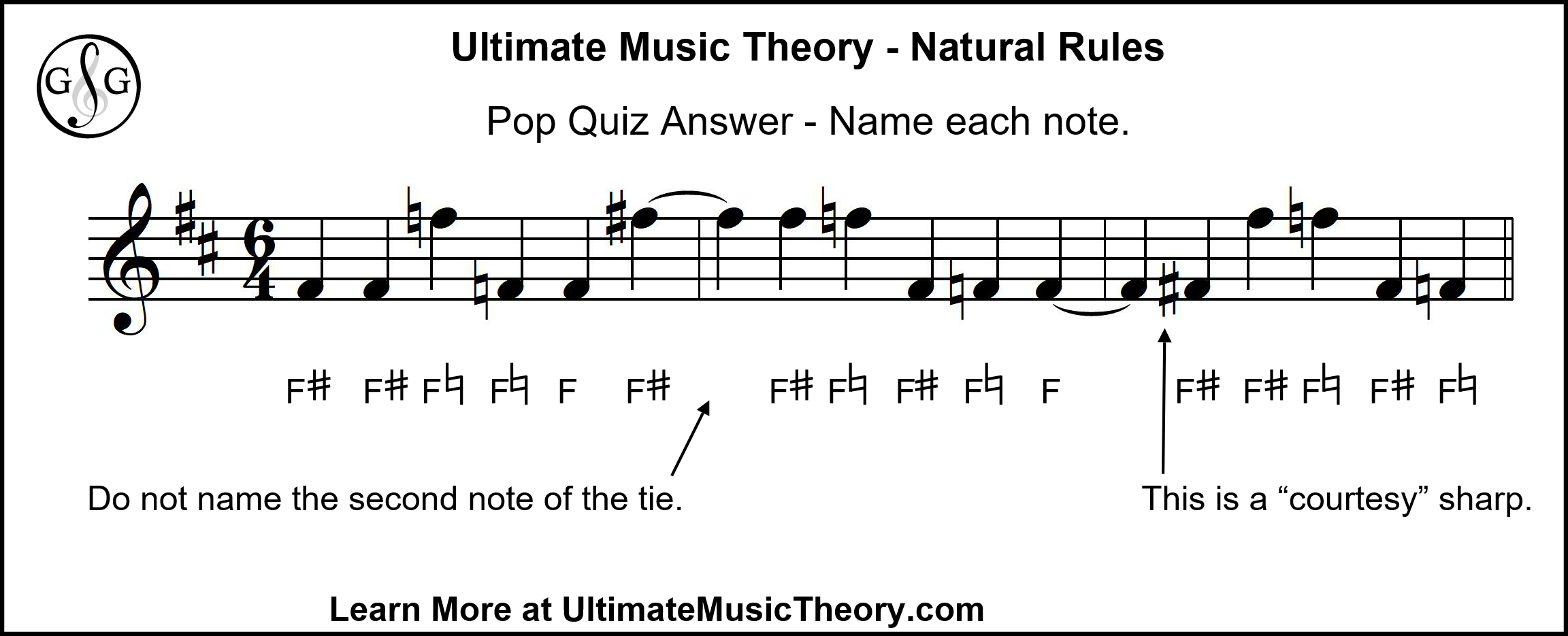Accidental Rules #1 – Natural Rules

A Natural Sign is an accidental that is used to cancel another accidental (a sharp, flat, double sharp or double flat). A Natural is written before the note (and after the letter name). There are specific Natural Rules that must be followed.
In this Blog, we will review:
- How to write the Natural Sign.
- Where to write the Natural Sign.
- When to write the Natural Sign.
These Natural Rules are very important for Students (and Teachers) to know, understand and use.
Do you know all the Natural Rules? Are you ready to learn?
Natural Rules - How Do You Write a Natural Sign?
Students do not need to write a Natural Sign as if they are a Computer Program. We do not need that shading and thick/thin line 'thing" when we write a Natural Sign. (Thank Goodness!)
Writing a Natural Sign is taught on:
- Page 41 in the Music Theory Beginner B Workbook.
- Page 72 in the Prep 1 Rudiments Workbook.
- Page 24 in the Basic Rudiments Workbook.
Students can write a Natural Sign using the Simple Method (2 horizontal straight lines) or using the Fancy Method (with the 2 horizontal lines angled slightly upwards). Either is acceptable.

The Memory Mnemonic of "L + 7" is used to create a picture of that Natural Sign. However, we do not literally write an L and a 7 (since we need the lines to be 2 vertical lines and 2 parallel horizontal lines).
Natural Rules - Where Do You Write a Natural Sign?
Rule #1 - The inside square of the Natural Sign must be on the same line as the notehead or in the same space as the notehead.
Rule #2 - The Natural Sign is written before the note and after the letter name.
Notice that, when writing the Natural Sign for a space note, we must avoid writing the 2 horizontal straight lines directly on top of the staff lines.
These 2 horizontal straight lines can be:
- written slightly above/below the staff lines (so that they are not right on top of the staff lines).
- angled upwards slightly (so that they are angled differently from the straight staff lines).


Natural Rules - When Do We Write Them?
I remind my Students of these 2 Natural Rules:
- When we Need to See the Natural Sign, we Need to Say (Name, Write) the Natural Sign.
- When we See the Natural Sign, we Say (Name, Write) the Natural Sign.
In Example #1, the b flat minor melodic scale is written using accidentals. Yes, in b flat minor, the notes G and A are flat (according to the Key Signature). In the melodic minor scale, the sixth note (G flat) and the seventh note (A flat) are raised one chromatic semitone/half step.
In Example #1, we are using accidentals. We do not SEE the G flat or the A flat (no Key Signature), so we do not need to WRITE the natural signs. There is nothing that has to be cancelled by writing a Natural Sign accidental.
In Example #2, we are using a Key Signature. Therefore, any G is actually a G flat, and any A is actually an A flat. To raise the 6th and 7th notes in the ascending melodic minor scale, we need to cancel the G flat and the A flat. We need to use Natural Signs to raise those notes (and cancel their "flat" names/tonalities).
Natural Rules - Pop Quiz
Let's have some fun! Name each note on this staff.
As you look at this example, do you see the tie? There are rules for naming tied notes with accidentals. Click here to read this blog!
Another great blog to review is the Writing Accidentals Blog. This blog will simplify how to write all the accidentals (not just the Natural Sign).

Natural Rules - BONUS! What is a Redundant Natural Sign and what is a Courtesy Natural Sign.
The word Redundant means:
- not or no longer needed or useful; superfluous.
- able to be omitted without loss of meaning or function.
A Redundant Natural Sign (or a Redundant Accidental) occurs when you write a Natural Sign when you do not need to write the Natural Sign.
The word Courtesy (as it pertains to accidentals) means:
- written as a reminder (a "courtesy"), although it is not technically required.
Composers will often use Courtesy Accidentals as a reminder of the pitch change (sharp, flat or natural). A Courtesy Accidental is written as a courtesy - not as being "theoretically correct".
In other words, the rules of theory state that we do not need to write the accidental there. However, the Composer is just reminding you of their intent for that pitch.
A Courtesy Natural might be used when (for example) a student has to play C Sharp in the Bass Staff, but just good old plain "C" (C Natural) in the Treble Staff. The Composer may choose to write a Courtesy Natural on the Treble Staff C to remind the Student that it is NOT C Sharp (and there is a C Sharp in the Bass Staff).
I would encourage you to explore finding Courtesy Accidentals in your Advanced Repertoire. (And what a great idea for a blog! Stay tuned!)
Natural Rules - Pop Quiz Answers.
Here are the answers to our Pop Quiz. How did you do?
If you have any questions, please comment below!
And remember - there is a lot of published music out there that has very poorly notated music. Just because the piano player next door wrote a piece of music and used natural signs on every note that was to be played as a "natural" does not mean that this is the correct theoretic way to write music!
Theory has rules. Thank you for taking the time to learn the Natural Rules.


Ultimate Music Theory Certification Course Online Teacher Training includes: 50 Video Sessions, All Materials, Online Support,
Exam Marking & Certificate!
Click HERE to discover what you will learn in the Ultimate Music Theory Certification Course. Your professional development Online Teacher Training starts here.
Keep on Learning... With a Smile and a Song!
Shelagh McKibbon-U'Ren


Hello Shelagh
Just to be clear, a note written an octave below or above cancels out the natural sign; as is show in the Pop Quiz Answer where the F sharp and F natural occurs; is that another Natural rule?
Hi Kamara:
An accidental on (for example) Space #1 does not in any way affect the note (with the same letter name, but at a different pitch/octave) on Line #5 (or any other note on the staff or using ledger lines). An accidental only applies to the note on the line or in the space where the accidental is written.
So, if A is Sharp (using an accidental) on Space #1 of the Bass Staff, the A on Line #5 is just “A”. That sharp on Space #1 does not affect Line #5 (or any other A).
Remember that this example has a KEY SIGNATURE! That is the reason why we need those naturals there. That F# in the Key Signature means that we need to have naturals on the F when we do not want it to be F#.
Great blog idea!
Shelagh